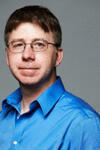Russell Hart
We have developed a novel quantum scattering interferometer to make direct and unambiguous measurements of quantum-mechanical scattering phase shift differences. The scattering phase shifts depend very sensitively on the underlying atom-atom interactions, and as such, these measurements are vitally important to many areas of contemporary atomics physics.
We make these measurements in a juggling atomic fountain clock. To juggle atoms, we launch two clouds of laser-cooled and optically pumped cesium atoms in rapid succession, with a range of relative velocities, between the 6.5–17 cm/s. We scatter atoms, prepared with a π/2 pulse, in a coherent superposition of the two clock states, 3,0〉 and 4, 0〉, off of atoms prepared in a pure |F, mF) hyperfine ground state. A portion of the atom’s wavefunction scatters. Of this portion, each clock state scatters with a phase shift. A second π/2 pulse converts the phase of the coherence of the clock states to a population difference. The variation of the phase of the second π/2 pulse maps out the phase of the coherence of the clock states as a Ramsey fringe. We detect the scattered or the unscattered part of each atom’s wavefunction, which can be distinguished by their velocities. The Ramsey fringes of the scattered atoms are phase shifted by the difference of the scattering phase shift for each clock state.
The ability to directly observe the quantum scattering phase shifts with this technique distinguishes it from previous measurements of frequency shifts in atomic clocks and other scattering measurements. The phase shift can be measured accurately because it does not depend on the atomic density to lowest order. We experimentally observe that the phase shift does not depend on density and that it is a phase shift and not a frequency shift. We also probe the energy dependence of the scattering phase shift and the variation with scattering angle. The technique can probe a wide variety of scattering channels as a function of collision energy, partial angular momentum wave, and magnetic field. The bulk of these first measurements probed the scattering of the clock states off of |4, 4〉.
We compare the precision of our measurement with state of the art measurements of atom interactions, and suggest future applications for our scattering interferometer.
